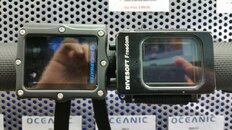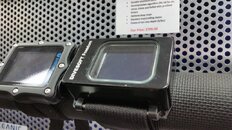A couple things that give me pause.
Short/Long button press interface. It sounds great, like you've got all sorts of options, but in reality, those types of interface suck when you're anywhere other than in the dive store. Gloves? Dry gloves? Dry glove leak with freezing hands? It may be a personal thing, but immediately it doesn't instill excitement. A button press should be a button press.
1-button gas switches. How is this implemented? Would really suck if your drysuit ring swaps gases on you. A 2 button press is ideal because it is still simple, and still far harder to accidentally switch gases. Not so much a problem for rec dives, but deep technical and/or cave dives, this could have serious implications when minutes added turns into hours of deco added.
Tilt/tap/shine interface is just asking for something going screwy. What happens when your buddy swipes his light over you, or you smack your hand against a tank while adjusting the leash length and your computer does something wonky that you don't notice. May be nothing, may be something.
USB connections are bad. It's one more thing to remember to have to make sure is secure.
It's made in the Czech Republic. Nothing wrong with the quality of the stuff, but if something does happen, it's a long trip back and forth, even if your LDS handles it. It's not like a drysuit that you can ship off to Steve Gamble no matter who made it, it's a sensitive piece of electronics that may or may not need to ship halfway across the world for service.
Even if it is better than the Shearwater stuff (although it seems increasingly subjective at this point) is it worth it to me to deal with the negatives? Not in my mind. There's nothing in this that's better to the point that it's worth "upgrading."
So is it "better?" Maybe. Is it "better enough?" Doesn't seem to be. In the end it's a choice though, and it's no cheaper than a Shearwater with the same capability. Passing of added complexity as a benefit, especially in the technical diving realm, doesn't always actually equate to being beneficial. It's something the purchaser has to decide for themselves.
Short/Long button press interface. It sounds great, like you've got all sorts of options, but in reality, those types of interface suck when you're anywhere other than in the dive store. Gloves? Dry gloves? Dry glove leak with freezing hands? It may be a personal thing, but immediately it doesn't instill excitement. A button press should be a button press.
1-button gas switches. How is this implemented? Would really suck if your drysuit ring swaps gases on you. A 2 button press is ideal because it is still simple, and still far harder to accidentally switch gases. Not so much a problem for rec dives, but deep technical and/or cave dives, this could have serious implications when minutes added turns into hours of deco added.
Tilt/tap/shine interface is just asking for something going screwy. What happens when your buddy swipes his light over you, or you smack your hand against a tank while adjusting the leash length and your computer does something wonky that you don't notice. May be nothing, may be something.
USB connections are bad. It's one more thing to remember to have to make sure is secure.
It's made in the Czech Republic. Nothing wrong with the quality of the stuff, but if something does happen, it's a long trip back and forth, even if your LDS handles it. It's not like a drysuit that you can ship off to Steve Gamble no matter who made it, it's a sensitive piece of electronics that may or may not need to ship halfway across the world for service.
Even if it is better than the Shearwater stuff (although it seems increasingly subjective at this point) is it worth it to me to deal with the negatives? Not in my mind. There's nothing in this that's better to the point that it's worth "upgrading."
So is it "better?" Maybe. Is it "better enough?" Doesn't seem to be. In the end it's a choice though, and it's no cheaper than a Shearwater with the same capability. Passing of added complexity as a benefit, especially in the technical diving realm, doesn't always actually equate to being beneficial. It's something the purchaser has to decide for themselves.





